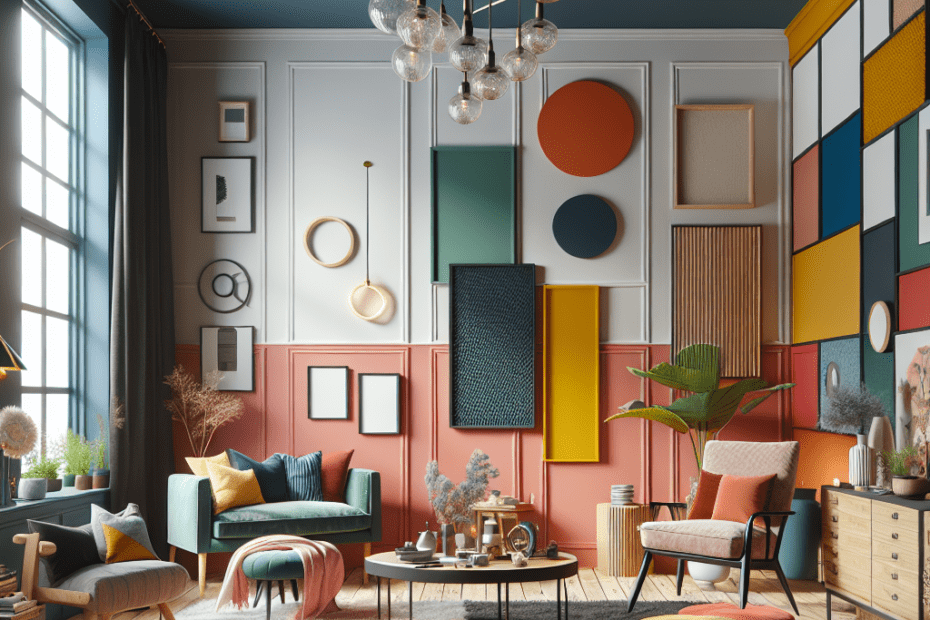“`html
How to Use Bold Color Blocking in Eclectic Interiors
One exciting way they transform living spaces is through color blocking in eclectic design. It involves combining bold and contrasting colors to make a space lively and vibrant. The use of color blocking in eclectic interiors has gained significant popularity due to its energy and appeal. In 2022, a survey by Houzz revealed that 55% of homeowners chose eclectic design elements, noting the creative freedom it offers when using bold hues.
The Basics of Color Blocking
Color blocking is all about pairing solid, bright colors to create eye-catching visual effects. It’s a concept that originated in the fashion world but has powerfully influenced interior design. When they experiment with color blocking, they combine two or more colors that stand out against each other. This method can make any room look unique and dynamic.
They need to understand the color wheel and choose colors that either contrast sharply or complement each other. For example, blue and orange or green and pink can create beautiful contrasts, while different shades of blue can establish a soothing and cohesive look.
Essential Color Blocking Techniques
There are several color blocking techniques they can use to add flair to their eclectic interiors:
- Accent Walls: They can paint a single wall in a vivid color to make it a focal point. This technique adds depth without overwhelming the entire space.
- Furniture and Decor: Introducing colorful furniture pieces or decor elements can effectively incorporate color blocking. A bright yellow sofa or a red coffee table adds interest and character.
- Textiles: They can use rugs, curtains, or cushions in contrasting colors to bring in the color-blocked effect, making the room feel cohesive.
Creating Balance with Neutral Base Colors
While using bold colors, it is crucial they maintain balance by incorporating neutral base colors. White, gray, or beige can anchor the vibrant hues, ensuring the room doesn’t become overwhelming. Neutrals can also enhance the intensity of the color blocking, allowing bright colors to pop.
Psychological Impact of Colors
The choice of colors can significantly affect how they feel in a space. Here’s a basic guide to some common colors used in color blocking:
| Color | Psychological Effect |
|---|---|
| Red | Stimulates energy and passion |
| Blue | Evokes calmness and tranquility |
| Green | Associated with nature and relaxation |
| Yellow | Enhances positivity and cheerfulness |
| Purple | Denotes luxury and creativity |
They can choose colors based on the mood they want to create in a room.
Blending Different Styles with Eclectic Design
The beauty of eclectic design lies in its flexibility. They can blend different styles, periods, and textures to achieve unique aesthetics. By merging vintage and contemporary pieces, using bold color blocking, they ensure a cohesive and harmonious look.
For example, modern art pieces can be combined with antique furniture, utilizing color blocking to tie the elements together. The eclectic style encourages them to be bold, adventurous, and confident in making unorthodox design decisions.
Common Mistakes to Avoid
- Overuse of Bright Colors: While bold colors make a statement, overusing them can create chaos. They should ensure there’s balance with some softer tones or neutrals.
- Ignoring Proportion and Scale: Large blocks of color might overwhelm a small room. It’s vital they consider the size and scale of their space when applying this method.
- Lack of Cohesion: Although eclectic design thrives on variety, there still needs to be some cohesive elements, like a recurring color or theme, to avoid a cluttered feeling.
Key Takeaways
- Color blocking mixes bold and contrasting colors to energize and personalize spaces.
- Accent walls, colorful furniture, and textiles are effective color blocking techniques.
- Balance bold colors with neutral bases for appealing results.
- Don’t overwhelm the space; aim for a blend that maintains harmony.
- Be mindful of the room’s size to ensure the right proportion of color.
FAQs
- What is color blocking in interior design?
Color blocking is the use of bold and contrasting colors in home design to create visual impact.
- How do they choose colors for color blocking?
They should consider contrasting or complementary colors on the color wheel to fit their desired mood.
- Can they use color blocking in small spaces?
Yes, they can, but they should be mindful of proportion to ensure the space doesn’t feel cluttered.
- What role do neutral colors play in color blocking?
Neutral colors ground the more vibrant hues, preventing designs from becoming overwhelming.
- Is eclectic design suitable for all homes?
Yes, it suits any home that desires creativity and personalization, allowing for the mix of various styles.
“`
Using bold color blocking in eclectic interiors offers homeowners a chance to showcase their personality and creativity. By understanding the rules and pitfalls of this design approach, they can transform a simple space into an artistic haven.
